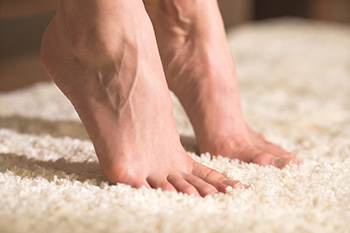
Many people incorporate appropriate leg exercises into their running regime, but may neglect their feet. The feet are the foundation of the body and provide balance and mobility for everyday activities. It is important for the feet to maintain strength, and this can be helpful in preventing painful injuries. Weak foot muscles may affect the arch and can result in plantar fasciitis, which causes severe pain and discomfort. Popular foot strengthening exercises consist of picking up marbles or curling a towel with the toes. These exercises can benefit both local and global muscles, and may lead to having a pain-free running experience. Many runners perform what is referred to as the short foot exercise. This is done by sitting in a chair with their feet on the floor, while bringing the ball of the foot toward the heel. It is important to refrain from crunching the toes, and this may help to shorten the specific muscles and ultimately strengthen the arch. If you would like more information about the importance of exercising the feet, it is suggested to visit a podiatrist.
Exercising your feet regularly with the proper foot wear is a great way to prevent injuries and build strength. If you have any concerns about your feet, contact one of our podiatrists from Lovely Foot Associates, PC. Our doctors can provide the care you need to keep you pain-free and on your feet.
Exercise for Your Feet
Exercise for your feet can help you gain strength, mobility and flexibility in your feet. They say that strengthening your feet can be just as rewarding as strengthening another part of the body. Your feet are very important, and we often forget about them in our daily tasks. But it is because of our feet that are we able to get going and do what we need to. For those of us fortunate enough to not have any foot problems, it is an important gesture to take care of them to ensure good health in the long run.
Some foot health exercises can include ankle pumps, tip-toeing, toe rises, lifting off the floor doing reps and sets, and flexing the toes. It is best to speak with Our doctors to determine an appropriate regimen for your needs. Everyone’s needs and bodies are different, and the activities required to maintain strength in the feet vary from individual to individual.
Once you get into a routine of doing regular exercise, you may notice a difference in your feet and how strong they may become.
If you have any questions please feel free to contact our office located in Johnstown, PA . We offer the newest diagnostic and treatment technologies for all your foot and ankle needs.
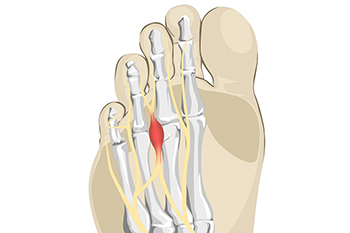
Some people feel the sensation of having a small pebble in their sock or shoe, and this can be a symptom of the foot condition known as Morton’s neuroma. It can develop as a result of wearing shoes that do have enough room in the toe area to move freely in. High heels can fall into this category and can affect women who frequently wear this type of shoe. This ailment affects the nerve between the third and fourth toes and can cause severe pain and discomfort. The nerve can become compressed and irritated, and mild relief may be felt when the shoes that are worn have a wider toe box. This condition will not improve when high heels are consistently worn, and surgery may be necessary to remove or repair the nerve. Patients may find some relief when anti-inflammatory medications are taken and the affected foot is massaged. If you have pain in this part of your foot, it is suggested that you visit a podiatrist who can diagnose and treat Moton’s neuroma.
Morton’s neuroma is a very uncomfortable condition to live with. If you think you have Morton’s neuroma, contact one of our podiatrists of Lovely Foot Associates, PC. Our doctors will attend to all of your foot care needs and answer any of your related questions.
Morton’s Neuroma
Morton's neuroma is a painful foot condition that commonly affects the areas between the second and third or third and fourth toe, although other areas of the foot are also susceptible. Morton’s neuroma is caused by an inflamed nerve in the foot that is being squeezed and aggravated by surrounding bones.
What Increases the Chances of Having Morton’s Neuroma?
Morton’s neuroma is a very treatable condition. Orthotics and shoe inserts can often be used to alleviate the pain on the forefront of the feet. In more severe cases, corticosteroids can also be prescribed. In order to figure out the best treatment for your neuroma, it’s recommended to seek the care of a podiatrist who can diagnose your condition and provide different treatment options.
If you have any questions, please feel free to contact our office located in Johnstown, PA . We offer the newest diagnostic and treatment technologies for all your foot care needs.
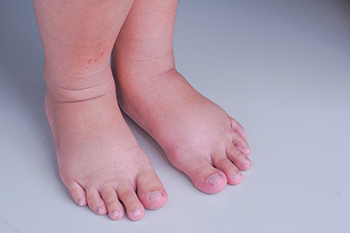
The feet are the foundation of the body and are capable of providing adequate balance and support. There are several bones, muscles and tendons that each foot has, and all work together to provide mobility. Patients who stand for long periods may develop edema, which is the medical term for swollen feet. Gravity can cause the blood to pool in the lower legs and feet, and shoes can become tighter. Swollen feet may also be prevalent among pregnant women and people who eat foods with excessive amounts of salt. Swollen feet may be reduced when frequent walking is done and salty foods are reduced. It is helpful to drink plenty of water daily, in addition to wearing compression socks or stockings. Being obese may lead to developing swollen feet, and it is beneficial to eat healthy foods. This may help to reduce or eliminate swollen feet. If your feet have become swollen, it is suggested that you visit a podiatrist who can correctly diagnose and offer treatment options for this problem.
Swollen feet can be a sign of an underlying condition. If you have any concerns, contact one of our podiatrists of Lovely Foot Associates, PC. Our doctors can provide the care you need to keep you pain-free and on your feet.
Swollen feet are a common ailment among pregnant women and people who stand or sit for extended periods. Aging may increase the possibility of swollen feet and patients who are obese often notice when their feet are swelling too. There may be medical reasons why swollen feet occur:
Swollen feet can also be caused by bone and tendon conditions, including fractures, arthritis, and tendinitis. Additionally, there may be skin and toenail conditions and an infection may cause the feet to swell. Patients who take medicine to treat high blood pressure may be prone to getting swollen feet.
Many patients elevate their feet to help relieve the swelling and this is generally a temporary remedy. When a podiatrist is consulted the reason behind the swelling can be uncovered and subsequently treated.
If you have any questions please feel free to contact our office located in Johnstown, PA . We offer the newest diagnostic tools and technology to treat your foot and ankle needs.
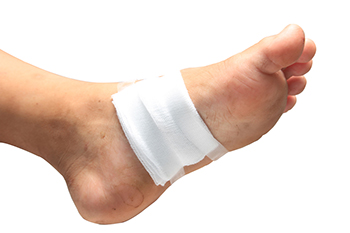
The skin, which is the largest organ in the body, consists of layers called epidermis, dermis, and hypodermis. It serves as the body’s first barrier to pathogens, ultraviolet light, chemicals, and injury. When the skin is grazed, its outer layer is damaged. When the skin is cut, depending on the depth and size of the wound, two or more layers may be injured. It is important to take certain measures when faced with wounds on the feet and ankles. First, wash your hands before touching the wound. Next, try to stop the bleeding by placing a sterile pad on the wound and applying pressure. If bleeding continues, it is important to get medical help immediately. Clean the wound and try to remove dirt or gravel particles, wiping from the center of the wound outward. Avoid using cotton balls or other materials that can leave fibers inside the wound. Then cover the wound with a sterile bandage. In severe cases, or if the wound on your foot shows signs of infection, it is suggested that you visit a podiatrist who can safely and properly treat it.
Wound care is an important part in dealing with diabetes. If you have diabetes and a foot wound or would like more information about wound care for diabetics, consult with one of our podiatrists from Lovely Foot Associates, PC. Our doctors will assess your condition and provide you with quality foot and ankle treatment.
What Is Wound Care?
Wound care is the practice of taking proper care of a wound. This can range from the smallest to the largest of wounds. While everyone can benefit from proper wound care, it is much more important for diabetics. Diabetics often suffer from poor blood circulation which causes wounds to heal much slower than they would in a non-diabetic.
What Is the Importance of Wound Care?
While it may not seem apparent with small ulcers on the foot, for diabetics, any size ulcer can become infected. Diabetics often also suffer from neuropathy, or nerve loss. This means they might not even feel when they have an ulcer on their foot. If the wound becomes severely infected, amputation may be necessary. Therefore, it is of the upmost importance to properly care for any and all foot wounds.
How to Care for Wounds
The best way to care for foot wounds is to prevent them. For diabetics, this means daily inspections of the feet for any signs of abnormalities or ulcers. It is also recommended to see a podiatrist several times a year for a foot inspection. If you do have an ulcer, run the wound under water to clear dirt from the wound; then apply antibiotic ointment to the wound and cover with a bandage. Bandages should be changed daily and keeping pressure off the wound is smart. It is advised to see a podiatrist, who can keep an eye on it.
If you have any questions, please feel free to contact our office located in Johnstown, PA . We offer the newest diagnostic and treatment technologies for all your foot care needs.
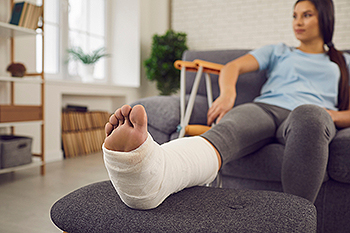
Ankle pain is most commonly caused by a sprained ligament or strained tendon in the complex ankle joint. However, in many cases it actually may be a sign that you have fractured an ankle bone. Signs of a fractured, or broken, ankle can include pain, an inability to bear weight, and swelling. If a bone is protruding from the skin, it is important to get immediate medical attention. To determine if the ankle pain is from a sprain or a fracture, a podiatrist will order an X-ray to be taken. If a bone is simply misaligned, this type of doctor may put it back in place. Anesthesia and pain medication is likely to be administered. In severe cases, surgery may be required, and plates, screws and wires may be used to keep the bones together. The ankle is generally placed in a cast, and recovery may take up to three months, depending on the severity of the fracture. If you believe you have a fractured ankle, it is suggested that you see a podiatrist for a diagnosis as quickly as possible.
Broken ankles need immediate treatment. If you are seeking treatment, contact one of our podiatrists from Lovely Foot Associates, PC. Our doctors can provide the care you need to keep you pain-free and on your feet.
Broken Ankles
A broken ankle is experienced when a person fractures their tibia or fibula in the lower leg and ankle area. Both of these bones are attached at the bottom of the leg and combine to form what we know to be our ankle.
When a physician is referring to a break of the ankle, he or she is usually referring to a break in the area where the tibia and fibula are joined to create our ankle joint. Ankles are more prone to fractures because the ankle is an area that suffers a lot of pressure and stress. There are some obvious signs when a person experiences a fractured ankle, and the following symptoms may be present.
Symptoms of a Fractured Ankle
If you suspect an ankle fracture, it is recommended to seek treatment as soon as possible. The sooner you have your podiatrist diagnose the fracture, the quicker you’ll be on the way towards recovery.
If you have any questions, please feel free to contact our office located in Johnstown, PA . We offer the newest diagnostic and treatment technologies for all your foot care needs.

Orthotics are medical devices that are worn inside the shoe. People who have foot pain or an abnormal foot structure may benefit from wearing orthotics, which may aid in completing daily activities. Custom-made orthotics may help patients who have diabetes, plantar fasciitis, or arch pain. These are designed and fitted by podiatrists and many benefits can be associated with wearing these types of orthotics. These can include improving the gait, or walking style, maintaining body alignment, and possibly relieving foot pain from arthritis. Wearing orthotics may reduce existing ankle pain, and it may be easier to walk. If you have foot pain for any reason, it is suggested that you speak with a podiatrist who can discuss the benefits of wearing custom-made orthotics and determine if this is the right choice for you.
If you are having discomfort in your feet and would like to try orthotics, contact one of our podiatrists from Lovely Foot Associates, PC. Our doctors can provide the care you need to keep you pain-free and on your feet.
What Are Orthotics?
Orthotics are inserts you can place into your shoes to help with a variety of foot problems such as flat feet or foot pain. Orthotics provide relief and comfort for minor foot and heel pain but can’t correct serious biomechanical problems in your feet.
Over-the-Counter Inserts
Orthotics come in a wide variety of over-the-counter inserts that are used to treat foot pain, heel pain, and minor problems. For example, arch supports can be inserted into your shoes to help correct overarched or flat feet, while gel insoles are often used because they provide comfort and relief from foot and heel pain by alleviating pressure.
Prescription Orthotics
If over-the-counter inserts don’t work for you or if you have a more severe foot concern, it is possible to have your podiatrist prescribe custom orthotics. These high-quality inserts are designed to treat problems such as abnormal motion, plantar fasciitis, and severe forms of heel pain. They can even be used to help patients suffering from diabetes by treating foot ulcers and painful calluses and are usually molded to your feet individually, which allows them to provide full support and comfort.
If you are experiencing minor to severe foot or heel pain, it’s recommended to speak with your podiatrist about the possibilities of using orthotics. A podiatrist can determine which type of orthotic is right for you and allow you to take the first steps towards being pain-free.
If you have any questions please contact our office located in Johnstown, PA . We offer the newest diagnostic and treatment technologies for all your foot and ankle needs.

Many people who are active find they are prone to getting ankle sprains. These are defined as the ankle turning in or out beyond its normal range of motion, and can happen from suddenly twisting it. There are two types of ankle sprains that are common, which are known as inversion and eversion sprains. Studies have shown the likelihood of incurring an ankle sprain may be greater when it has been sprained before. An ankle that has healed from a sprain may be weaker, which may compromise walking. This may cause more weight to be put on the other ankle, and may become weaker. Performing ankle stretches is beneficial in strengthening the ankles which may help to prevent ankle sprains and regain a normal range of motion once it has healed. If you have sprained your ankle, it is suggested that you confer with a podiatrist who can help you with treatment and effective prevention techniques.
Ankle sprains are common but need immediate attention. If you need your feet checked, contact one of our podiatrists from Lovely Foot Associates, PC. Our doctors can provide the care you need to keep you pain-free and on your feet.
How Does an Ankle Sprain Occur?
Ankle sprains take place when the ligaments in your ankle are torn or stretched beyond their limits. There are multiple ways that the ankle can become injured, including twisting or rolling over onto your ankle, putting undue stress on it, or causing trauma to the ankle itself.
What Are the Symptoms?
Preventing a Sprain
Treatment of a Sprain
Treatment of a sprain depends on the severity. Many times, people are told to rest and remain off their feet completely, while others are given an air cast. If the sprain is very severe, surgery may be required.
If you have suffered an ankle sprain previously, you may want to consider additional support such as a brace and regular exercises to strengthen the ankle.
If you have any questions please feel free to contact our office located in Johnstown, PA . We offer the newest diagnostic and treatment technologies for all your foot and ankle needs.
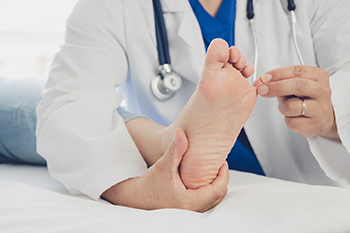
The field of medicine that is called podiatry treats conditions of the feet, ankles, and lower legs. The feet are considered to be the foundation of the body, and foot pain can wreak havoc on an individual’s quality of life. Foot pain can range from wearing shoes that do not fit correctly to enduring a traumatic or sudden foot injury. There are several branches of podiatry, consisting of sports medicine, forensic podiatry, and onco-podiatry, and qualified students can choose which one is best for them after completing an extensive education. This can begin with earning a bachelor’s degree, followed by pursuing a Doctor of Podiatric Medicine (DPM) program that will take four years. A surgery residency program begins at this time, which typically takes place in a hospital or clinic setting. Podiatrists can choose to have a private or group practice, work in extended care facilities, or practice in various health departments. If you are interested in pursuing a career as a podiatrist, it is suggested that you speak to this type of doctor who can address any concerns and answer any questions you may have.
If you are dealing with pain in your feet and ankles, you may want to seek help from a podiatrist. Feel free to contact one of our podiatrists from Lovely Foot Associates, PC. Our doctors can provide the care you need to keep you pain-free and on your feet.
What Is a Podiatrist?
A podiatrist is a doctor of podiatric medicine who diagnoses and treats conditions of the foot, ankle, and related structures of the leg. Your podiatrist may specialize in a certain field such as sports medicine, wound care, pediatrics, and diabetic care. Podiatrists have the ability to become board certified through training, clinical experience, and then taking an exam.
What Do Podiatrists Do?
On a daily basis, a podiatrist may perform the following activities:
It is very important that you take care of your feet. It’s easy to take having healthy feet for granted, however foot problems tend to be among the most common health conditions. Podiatrists can help diagnose and treat a variety of feet related conditions, so it is crucial that you visit one if you need assistance.
If you have any questions please feel free to contact our office located in Johnstown, PA . We offer the newest diagnostic and treatment technologies for all your foot and ankle needs.